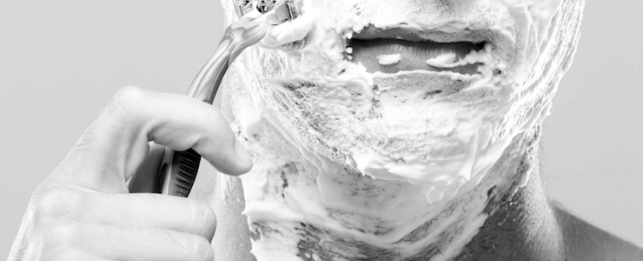Andrew Reeves, A\J Current Events blogger and environmental journalist:
The latest report from Environmental Defence outlining the myriad of toxic chemicals in men’s personal care products shouldn’t surprise anyone with even a rudimentary understanding of the chemical cocktails swimming around in women’s care products for the past five decades – likely more.
Andrew Reeves, A\J Current Events blogger and environmental journalist:
The latest report from Environmental Defence outlining the myriad of toxic chemicals in men’s personal care products shouldn’t surprise anyone with even a rudimentary understanding of the chemical cocktails swimming around in women’s care products for the past five decades – likely more.
But in The Manscape: The Dirt on Toxic Ingredients in Men’s Body Care Products, Environmental Defence tested 17 common men’s grooming products suggested to them by five men from across Canada, including aftershave, shampoo, body wash, shaving cream and deodorant.
All was done in the name of consumer safety to provide proof of what most have long suspected: that men, like women, are being poisoned on a daily basis by the products they purchase and use to keep clean.
And the results? Not good. Of the 17 products tested, Manscape reports that “four products contained probable human carcinogens, five products contained chemicals known to harm male reproductive health and ten products had artificial musks, some of which are shown to disrupt hormones in animals.”
To make sure there was no mistaking the potentially harmful impacts of putting your skin into daily contact with these products, the report’s authors state, “the chemicals we found are linked to cancer, birth defects, sperm damage, obesity, asthma and other chronic health problems.”
They go on: “Phthalates, a group of chemicals found in most fragranced products as well as poly-vinyl chloride (PVC), vinyl flooring and car parts, are particularly harmful to male reproductive health. They have also been linked to risk factors for testicular
cancer—the most common cancer among young men between 15-29 years old.”
Now – everyone should keep their composure! The good people at Environmental Defence have nothing invested in scaring young men into rubbing baking soda and water onto their face in lieu of shaving cream (although they do suggest a concoction of apple cider vinegar and water in place of some dandruff shampoos).
Rather, the report reinforces what consumers should know, and what men’s body care manufacturers likely hope young men with money in their pocket and a desire to look good (or just be clean) quickly forget – that in the market, the consumer calls the shots with spending habits and the choices we make.
The Toxic Ten
For consumers, Environmental Defence has created a handy pocket guide to the “Toxic Ten” products to look for on labels, including phthalates (which disrupt male reproduction), triclosan (a known carcinogen) and formaldehyde releasing agents (linked with leukemia). All should be avoided whenever possible.
For industry, Manscape recommends they remove the Toxic Ten from products for sale around the world. But closer to home, the report asks that manufacturers selling products in Canada omit the same products here that have already been banned in the European Union.
“If a chemical is banned in Europe, don’t use it in Canada,” the report states. “Many companies operate in both markets, and if a product makes someone more beautiful or handsome on one side of the Atlantic without a harmful chemical, it can work on the other side without it, too.”
Government doesn’t escape responsibility for this toxic mess, either. The report calls on the federal government to implement a European Union-style ban on certain chemicals known to have harmful effects on the human body and the natural environment when released into local water bodies. (Cosmetics, for example, when flushed down the toilet can end up in local waterways and have been known to change the sex of male fish to female.)
The lesser of many evils
On a personal level, as a male shopper under 30, I’m disappointed the report’s first recommendation for consumers is to choose safer products. I understand the argument that people must be personally accountable for their own consumer choices, but it worries me that the benchmark assumption of personal care products for men and women is that any commercial product will contain carcinogenic chemicals, and that the onus is on consumers to shop around such potentially devastating products.
It’s disturbing that the benchmark assumption is not that products are safe and there may be a few bad apples with chemicals to watch out for, but that most items on the shelf will, in excess, harm your body in some form or another. But if nothing else, reports like Manscape are valuable insights into just how distorted the personal care landscape for men and women has become, and how urgently the situation demands significant changes.
“Don’t panic,” the report states. “Yes, these results are cause for concern, but the problem is long-term exposure. Unless a user has a particular sensitivity to an ingredient, immediate ill effects are unlikely. The thing to keep in mind is that trace exposures add up.”
So listen up, men – chances are that bottle of Pert Plus you hide in back of the shower or that bottle of aftershave you throw in your gym bag for when you don’t have time to shower but don’t want to smell bad won’t develop into leukemia tomorrow, or destroy your ability to reproduce in a year. But over time, without warning, its damage builds up, like death by a thousand showers, shaves and swipes of deodorant in the morning.
But ultimately, the power is yours to make smarter choices.
We also got a few A\J friends to weigh in on the report. Here’s what they had to say:
Sam Toman, Communications Officer, University of Waterloo’s Faculty of Environment
Reading the findings of Environmental Defence’s report on the toxins found in men’s grooming products is disturbing — but not surprising. Maybe it was those pictures of tortured rabbits on the walls of my highschool, but I have always been highly suspicious of the cosmetics industry.
What I think this study does illuminate is that most men probably don’t read the labels of the cosmetics they use. There was an interesting article in The Atlantic recently stating that people who read nutrition labels on food packages are skinnier than those who didn’t. In fact, women who read labels were, on average, eight pounds lighter than those who didn’t.
If what the Environmental Defence study says is true, men are buying more cosmetics than ever in an attempt to look better. Surely those same men image-conscious are reading food labels to stay fit, and could easily start reading cosmetics labels to avoid other health hazards.
A big problem I see is that the names of the chemicals that should be avoided are hard to remember. Cyclomethicone, Cyclotetrasiloxane, Cyclopentasiloxane, and Cyclohexasiloxane are a lot harder to keep track of than sugar and sodium. If the government can help simplify these labels it will go a long way to helping us avoid the nastiness.
Personally I will certainly start reading cosmetics labels more diligently. The last thing I need in my life is an ingredient containing, “estrogen-mimicking chemicals found in breast cancer tissue.” It won’t be a big problem for me though. I rarely use deodorant, I sport a beard, I’ve lost nearly all of my hair, and I usually just use the artisanal organic soap my girlfriend buys. And yes… believe it or not Stinky Von Beardo does have a girlfriend.
Jennifer Frietas, holistic beauty consultant and owner of Olivier Soaps Waterloo:
Apparently, men are becoming more and more vain, and have finally joined women on the slippery slope of making ourselves more beautiful – while making both ourselves and the environment very sick in the process.
The report does a great job of increasing awareness but is by no means complete. For example, Nivea’s Sensitive Shave Gel contains even more harmful chemicals not tested in the report (i.e. isobutene, polyethylene glycol), but it’s hard to watch out for these ingredients when the company’s website doesn’t even disclose the ingredient list. How are we supposed to navigate this crazy, toxic world we are living in? Our government has yet to protect us and the corporations making these products are more interested in protecting their bottom lines.
My recommendation to the average consumer? Buy products that list ingredients that you can pronounce, and use less of them. Eventually, profits for the conglomerates will lessen and they will be forced to change. Keep expressing concerns to our government to regulate or ban these harmful chemicals. 30 per cent of the population acquires cancer, and that statistic is just too ugly.
The full Manscape report is available through the Environmental Defence website. You can also download a pocket guide to the Toxic Ten, also from Environmental Defence, to carry with you to the store or you can sign their petition to Health Canada to modernize cosmetics regulations.
Some useful resources for checking out products before you buy include the Environmental Working Group’s Skin Deep Cosmetics Database and the Good Guide database.
Andrew Reeves is the Editor-in-Chief of Alternatives Journal. Overrun, his book about Asian carp in North America, will be published in Spring 2019 by ECW Press. His work has also appeared in the Globe & Mail, Spacing and Corporate Knights. Follow him on Twitter.













